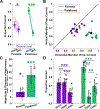Asymmetries in Foveal Vision
- PMID: 40695598
- PMCID: PMC12410043
- DOI: 10.1523/JNEUROSCI.0055-25.2025
Asymmetries in Foveal Vision
Abstract
Visual perception is characterized by known asymmetries in the visual field; human's visual sensitivity is higher along the horizontal than the vertical meridian, and along the lower than the upper vertical meridian. These asymmetries decrease with decreasing eccentricity from the periphery to the center of gaze, suggesting that they may be absent in the [Formula: see text] foveola, the retinal region used to explore scenes at high-resolution. Using high-precision eyetracking and gaze contingent display, allowing for accurate control over the stimulated foveolar location despite the continuous eye motion at fixation, we investigated fine visual discrimination at different isoeccentric locations across the foveola and parafovea in 12 human observers (both sexes). Although the tested foveolar locations were only [Formula: see text] away from the center of gaze, we show that, similar to more eccentric locations, humans are more sensitive to stimuli presented along the horizontal than the vertical meridian. Whereas the magnitude of this asymmetry is reduced in the foveola, the magnitude of the vertical meridian asymmetry is comparable but, interestingly, the asymmetry is reversed: stimuli presented slightly above the center of gaze are more easily discerned than when presented at the same eccentricity below the center of gaze. Therefore, far from being uniform, as often assumed, foveolar vision is characterized by perceptual asymmetries. Further, these asymmetries differ not only in magnitude but also in direction compared to those present just ∼[Formula: see text] away from the center of gaze, resulting in overall different foveal and extrafoveal perceptual fields.
Copyright © 2025 the authors.
Conflict of interest statement
The authors declare no competing financial interests.
Figures




Update of
-
Asymmetries in foveal vision.bioRxiv [Preprint]. 2024 Dec 21:2024.12.20.629715. doi: 10.1101/2024.12.20.629715. bioRxiv. 2024. Update in: J Neurosci. 2025 Sep 3;45(36):e0055252025. doi: 10.1523/JNEUROSCI.0055-25.2025. PMID: 39763996 Free PMC article. Updated. Preprint.
References
-
- Anstis SM (1974) Chart demonstrating variations in acuity with retinal position. Vision Research 14:589–592. - PubMed
-
- Atchison DA, Pritchard N, Schmid KL (2006) Peripheral refraction along the horizontal and vertical visual fields in myopia. Vision Research 46:1450–1458. - PubMed
-
- Azzopardi P, Cowey A (1993) Preferential representation of the fovea in the primary visual cortex. Nature 361:719–721. - PubMed
MeSH terms
Grants and funding
LinkOut - more resources
Full Text Sources
